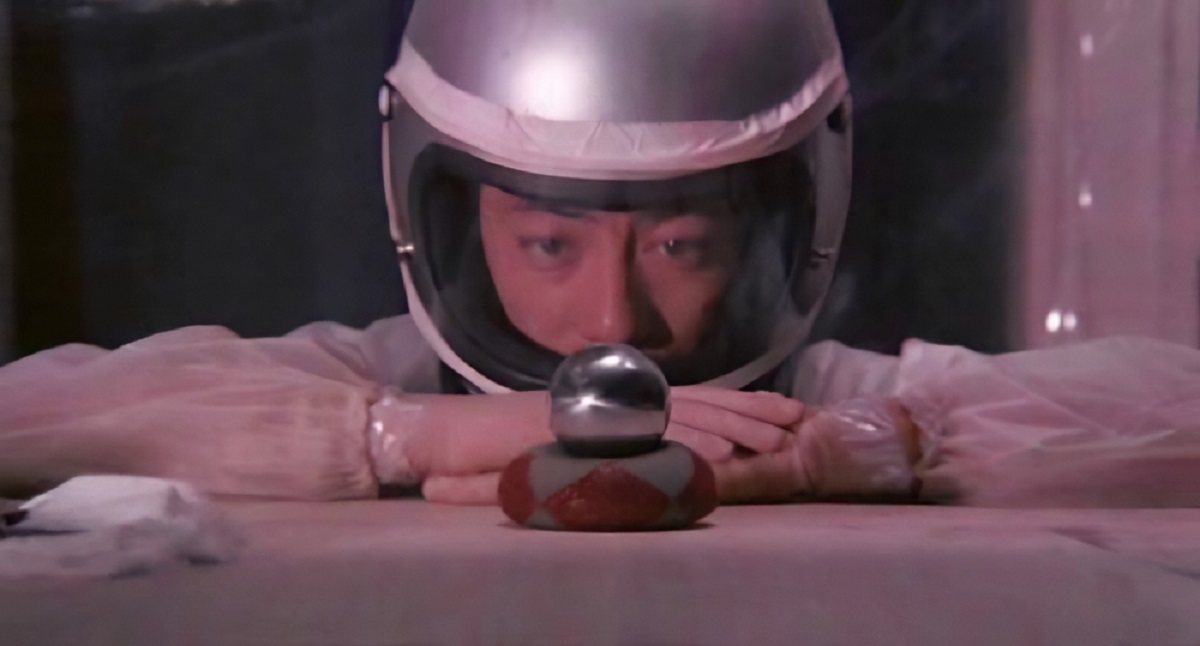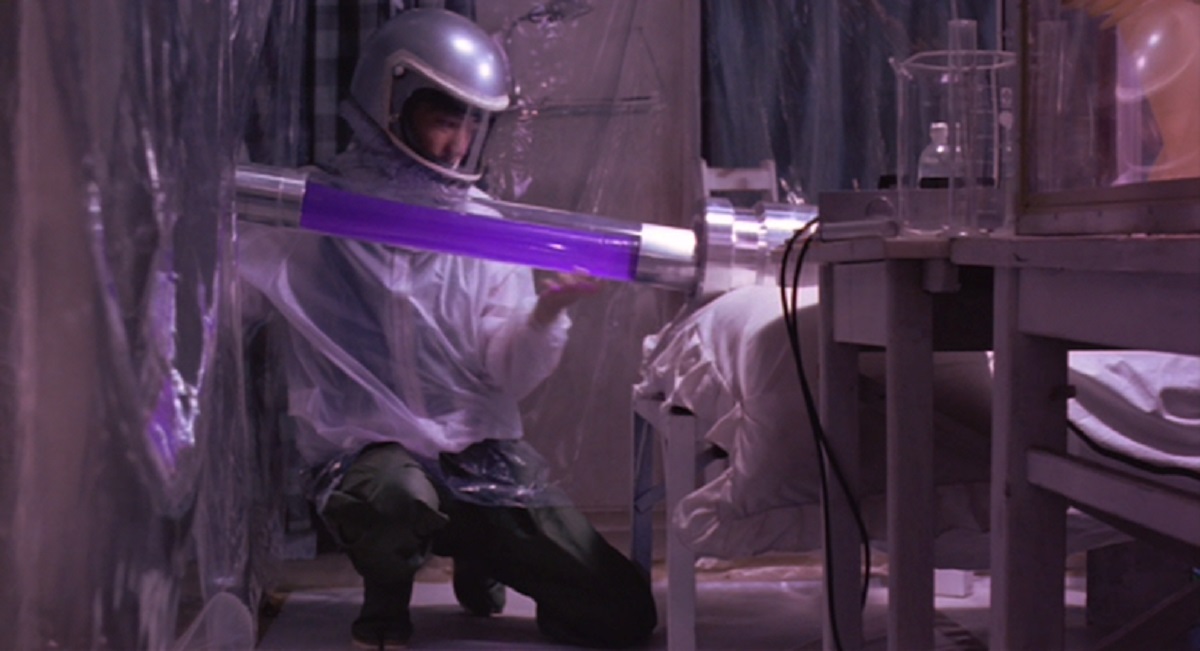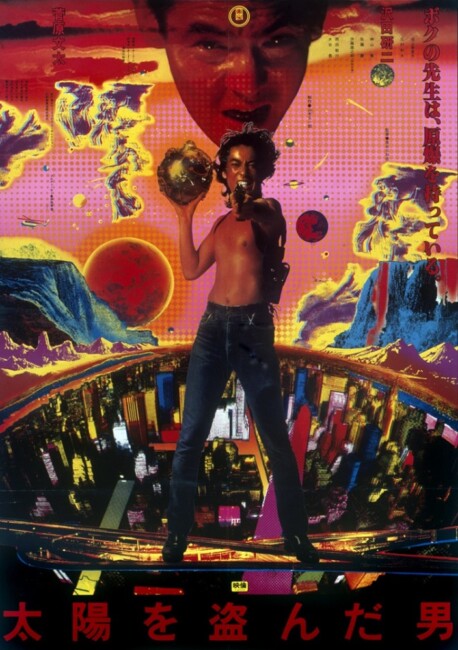(Taiyo wo Nusunda Otoko)
Japan. 1979.
Crew
Director – Kazuhiko Hasegawa, Screenplay – Kazuhiko Hasegawa & Leonard Schrader, Story – Leonard Schrader, Producer – Kei Ijichi, Photography – Tatsuo Suzuki, Music – Takayuki Inoue, Production Design – Yoshinaga Yoko’o. Production Company – Kitty Films.
Cast
Kenji Sawada (Makoto Kido), Bunta Sugawara (Inspector Yamashita), Kimiko Ikegami (Reiko ‘Zero’ Sawai), Kazuo Kitamura (Tanaka), Kei Sato (Dr Ichikawa), Yunosuke Ito (Ryukichi Yamazaki, Bus Hijacker)
Plot
Makoto Kido, a high school science teacher in Tokyo, is caught up as a man with a machine gun hijacks a bus of his pupils while on a field trip. Police Inspector Yamashita arrives and tricks the man into a peaceful resolution of the situation. Kido then hatches a scheme where he breaks into the Tokai Nuclear Power Plant and steals a canister of plutonium-239. In his apartment, he refines the plutonium to build an atomic bomb. He then begins to blackmail the government, insisting that Inspector Yamashita be his contact, and issuing demands for the likes of an extension of tv broadcast hours and that The Rolling Stones come to play in Japan.
The Man Who Stole the Sun is a Japanese film that has gained a reasonable reputation. It was one of only two films directed by Kazuhiko Hasegawa, who had previously made The Youth Killer (1976) and had written scripts for several Japanese sexploitation films. Following The Man Who Stole the Sun, Hasegawa quit directing altogether for reasons unclear.
The interesting name on the script is Leonard Schrader, the brother of director/screenwriter Paul Schrader of Taxi Driver (1976) and Cat People (1982) fame. Leonard lived in Japan for a number of years and co-wrote Paul’s films The Yakuza (1974), based on his own experiences in the Japanese criminal underworld, Blue Collar (1978) and Mishima: A Life in Four Chapters (1985), and directed one film himself with Naked Tango (1985). His best known work was the script for the award-winning Kiss of the Spider Woman (1985).
Surprisingly, The Man Who Stole the Sun seemed to presage a small mini-genre of films about individuals building their own atomic bombs. The same year as this came out there was also the The Deadly Dust (1979) episode of The Amazing Spider-Man, which was released as the film Spider-Man Strikes Back (1979) in which a group of university students build a bomb. A few years later, there was The Manhattan Project (1986) wherein a high-school teenager builds a bomb for a school science prize.
The film does leave you with some questions. I find it a hard stretch that anyone could just walk into a nuclear power plant core and it only being when they try to get away that a security alert is triggered. There is also the question of Kenji Sawada’s plutonium poisoning. He creates a handling environment but does so in his own apartment, using his own kitchen to bake and refine the plutonium in ways that leaves you balking at his inability to implement what should be elementary safety precautions ie. there would be radioactive materials left inside his stove afterwards. On the other hand, a little google fu tells me that plutonium is relatively safe to hold with your bare hands, even swallow – it is more inhaling it that causes problems, nevertheless …


The Man Who Stole the Sun is very much a film rooted in its era – an era where there was a payphone on every street corner; where the idea of caller display was non-existent; and Kenji Sawada’s schemes hinge on having 1 minute and 50 seconds before the police can trace where he is calling from; and an era where terrestrial tv broadcasts end at 9 pm. We even see theatre billboards for the Christopher Reeve starring Superman (1978) in the background.
Kido is oddly a character without any motivation given for the actions he does. He’s not a particular rebel, has no message or statement he is trying to make, at most he acts out of minor irritations like tv broadcasts cutting off during a baseball game. However, he is a likeable centre of the action and you can see in Kenji Sawada’s laidback untroubled performance that the film champions an anarchic spirit and general extending of the middle finger to authority.
The film gains a particular ingenuity during Kido’s schemes and games with the government. At one point, we see him dressing in drag and carrying the bomb around his waist as though he were a pregnant woman in order to walk in and place it in The Diet (the Japanese Parliament). His demands are hilariously banal – that the authorities extend tv broadcast hours past 9 pm so he can see the end of the baseball game; that they bring The Rolling Stones to Japan to give a concert (something they never did in reality until 1990, with The Stones having been denied visas prior to that over Mick Jagger’s drug possession conviction).
The Man Who Stole the Sun reaches a level of ingenuity when Kido organises a money drop in the middle of a city, only for the police to trace the call to a department store and Kido to switch track and tell them to scatter the money from the rooftops so he can make a getaway – and then inform the police that the location of the bomb is beneath the desk in the very hotel room they are in. The film climaxes with a great car chase sequence, before a climactic showdown on a rooftop between Kenji Sawada and detective nemesis Bunta Sugawara, which arrives at a decidedly demented ending.
Trailer here


